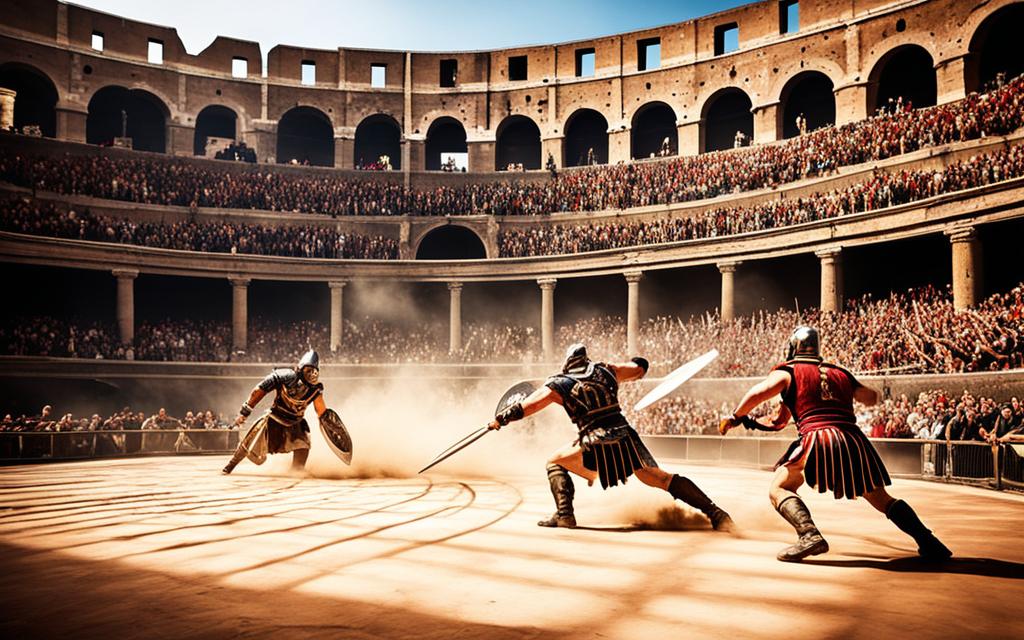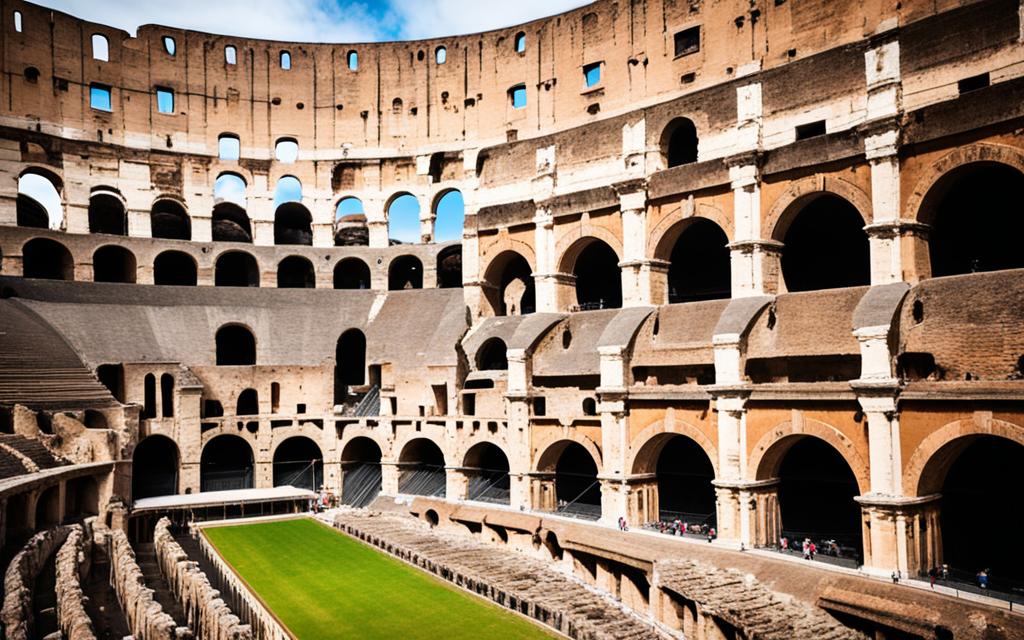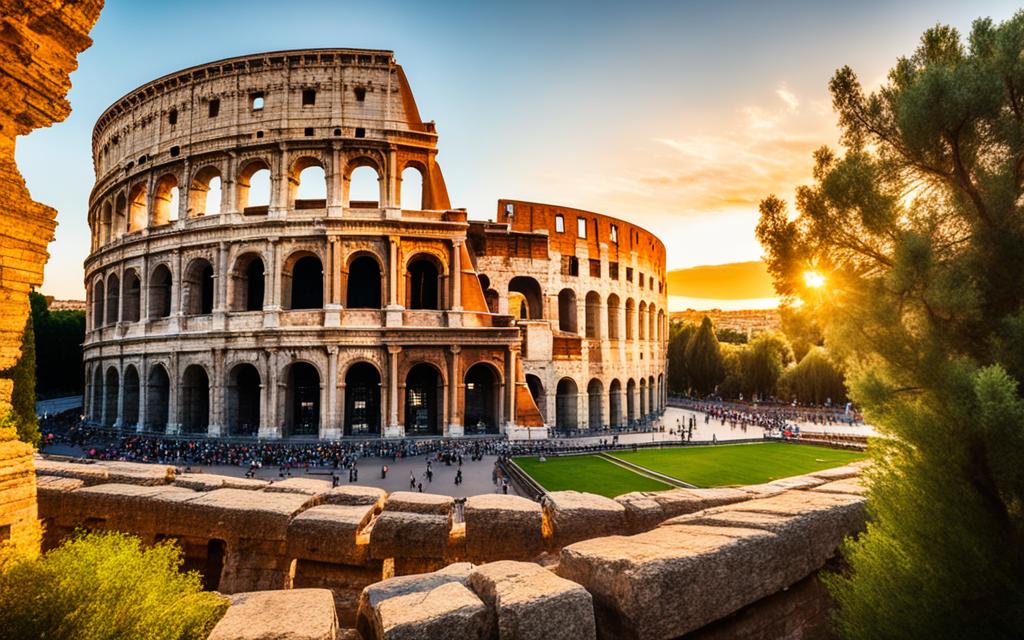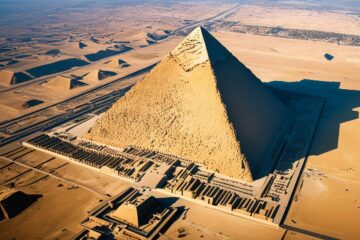When you see the tall arches and old stones of the Colosseum in Rome, you can’t help but feel amazed. This huge building shows how smart and skilled the ancient Romans were. It has inspired people all over the world for many years.
The Colosseum is a big part of Rome, also called the Flavian Amphitheater. It was built in the 1st century AD, showing off ancient Rome’s amazing architecture and engineering. This iconic structure has drawn people’s interest for years as one of Rome’s most famous buildings.
Key Takeaways
- The Colosseum is a testament to the engineering prowess and architectural genius of the ancient Roman Empire.
- As one of the most recognizable and well-preserved Roman structures, the Colosseum has captivated the imagination of people around the world for centuries.
- The Colosseum is a UNESCO World Heritage Site and one of the most popular tourist attractions in Italy.
- The Colosseum’s impressive dimensions and iconic elliptical design are a testament to the ingenuity and skill of Roman builders and engineers.
- The Colosseum’s rich history reflects the power and cultural significance of the Roman Empire, including its use for gladiatorial games and spectacles.
Unveiling the Grandeur of The Colosseum
The Colosseum showcases ancient Rome’s architectural genius. For centuries, it has stood as a key symbol. This amphitheater highlights the engineering might and skill of the Roman Empire.
A Monumental Landmark of Ancient Rome
The size and detail of the Colosseum are breathtaking. It’s a top site for global tourists. This amphitheater symbolizes Rome’s ambitious spirit and advanced techniques.
Architectural Marvel of the Roman Empire
The Colosseum is both stunning and a technical wonder of the Roman Empire. It shows off complex design and building methods. Its creation stands as a remarkable achievement of human engineering.
Delving into the History of the Colosseum
The Colosseum is a symbol of the Roman Empire’s strength and smart thinking. It has a rich history that shows the grand achievements and big dreams of old Rome. This famous building, called the Flavian Amphitheater, was built in the 1st century AD. It was under the Flavian dynasty’s rule, especially Emperor Vespasian.
Construction and Purpose of the Amphitheater
Building the Colosseum started in 72 AD and finished in 80 AD. It was an impressive example of the Roman Empire’s advanced building skills. The amphitheater was constructed on the grounds of Nero’s palace. It was done to show the new Flavian dynasty’s power. They wanted to please the Roman people.
The Colosseum’s main use was for shows and events. These included gladiatorial games, animal hunts, executions, battles shown again, and plays about myths. These activities were to keep the Roman public happy. They also showed off the Empire’s strength.
Gladiatorial Games and Spectacles
The most well-known events at the Colosseum were the gladiatorial games. In these, skilled fighters fought to the death. They were usually prisoners or criminals. These games were not just about strength. They showed the Roman Empire’s military power and desire to win.
Aside from the gladiatorial games, the Colosseum held many other shows. These included animal hunts, executions, and battles acted out again. Each show was planned to highlight the Roman Empire’s power and know-how. They kept the crowd interested. This helped keep the Colosseum as a symbol of Roman rule.

Exploring the Iconic Architecture
The Colosseum is one of the Roman Empire‘s greatest works. Its shape and size have amazed people for ages. It shows off the smart and skilled work of the Roman engineers who built it.
Elliptical Design and Impressive Dimensions
The Colosseum is designed in an oval shape. It’s about 620 feet long and 188 feet high. These dimensions, along with its smooth curves, make it a beautiful structure.
Engineering Marvels of Roman Construction
Building the Colosseum was a big challenge for the Roman builders. They used new methods and materials like Roman concrete. These helped make the amphitheater big enough for 80,000 people. The Colosseum is a key example of what Roman engineering was capable of.

The Colosseum: A Timeless Wonder
The Colosseum is a famous symbol of ancient Rome that still stands today. It has faced many challenges like earthquakes and fires, yet it remains standing. This stately structure shows the world the skill of the Roman Empire in building grand amphitheaters.
This ancient site is now a UNESCO World Heritage Site, making it a key place for tourists. People from all over come to see its beauty and learn about its storied past. Initially, it hosted gladiatorial games, but today represents the enduring power and cleverness of the Romans.
The Colosseum is a vivid reminder of the Roman Empire and its piece of Italy’s culture. Its shape against the sky highlights the ancient world’s ongoing influence and great achievements. It’s a place that showcases human creativity and effort, meant for all to visit.




